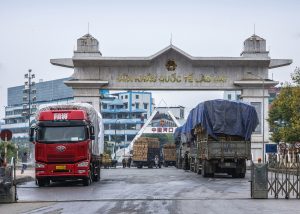Yesterday, China’s Foreign Ministry confirmed earlier reports that President Xi Jinping will visit Vietnam to meet top state officials and discuss upgrading the two countries’ relations.
As Reuters reported, paraphrasing ministry spokesperson Wang Wenbin, the Chinese leader will visit the country on December 12-13, for talks that “will focus on areas of political security, multilateral and maritime issues, and promote further strategic cooperation.”
According to a report by Nikkei Asia, which cited “four people familiar with the matter,” Xi and his Vietnamese counterparts will discuss the upgrade of the railway linking Kunming to the Vietnamese seaport of Haiphong, which currently operate on different gauges inside the two countries. The joint venture will fall under China’s Belt and Road Initiative, Nikkei reported.
Two sources also told the publication said rare earths will also be on the agenda during Xi’s visit. Perhaps not coincidentally, the Kunming-Haiphong railway, which was built by the French in the early 20th century, runs through regions of northern Vietnam containing considerable deposits of rare earth minerals.
Xi’s two-day trip to Vietnam will be just his fourth overseas visit of the year, following trips to Russia (March), South Africa (August), and the United States (November).
With Xi’s visit, Vietnam will also become the only nation to welcome the leaders of both China and the United States in 2023. U.S. President Joe Biden visited in September, during which he and senior Vietnamese officials elevated their relationship to a Comprehensive Strategic Partnership (CSP), placing the U.S. alongside China and Russia at the top of the nation’s diplomatic hierarchy.
The U.S. upgrade was just one of several with Western-leaning nations. Last week, Vietnam raised Japan to the same rank, and is reportedly in talks to do so with Singapore, Australia, and Indonesia.
While it is tempting to interpret these diplomatic upgrades as a setback for Beijing, the same period has also seen a rash of interactions between China and Vietnam, which will reach their culmination in the high pageantry that will accompany Xi’s visit next week.
Early last month, China’s Vice Foreign Minister Sun Weidong traveled to Hanoi and met with Vietnam’s Deputy Foreign Minister Nguyen Minh Vu. According to a report by Reuters, the two held “frank and friendly talks” and agreed to try to make the Sino-Vietnamese land border a border of “permanent peace” and “intergenerational friendship and prosperous development.” This was followed two weeks later by a visit to Ho Chi Minh City by Chinese Commerce Minister Wang Wentao, who in a meeting with Prime Minister Pham Minh Chinh pledged to further develop the bilateral trade relationship.
Most recently, Chinese Foreign Minister Wang Yi travelled to Hanoi to co-host the 15th meeting of the China-Vietnam Steering Committee for Bilateral Cooperation. In meetings with Vietnamese officials, including Nguyen Phu Trong, the head of the Communist Party of Vietnam (CPV), Wang discussed Chinese investment, particularly in high-tech areas, and the two nations’ ongoing disputes in the South China Sea.
As Chinese state media reported, Yi declared that the two nations’ communist parties “have established solid political mutual trust and profound comradeship,” and that Vietnam and China “share the same aspiration and destiny.”
Seen against a backdrop of diplomatic upgrades with Western and non-aligned partners, the intense pace of China-Vietnam diplomacy is a neat encapsulation of the ways in which Vietnam manages relations with its giant northern neighbor. It also reflects the operating principle of Vietnam’s omnidirectional foreign policy, which seeks to balance each stepwise advance in relations with Washington with a similar step vis-à-vis Beijing, wrapped in assurances of peaceful intent and everlasting fraternal amity.
The reason, as Khang Vu wrote for The Diplomat in October, is the significant asymmetry of power between Vietnam and China, which for Hanoi places a premium on keeping relations of Beijing stable. Indeed, such is Vietnam’s tight integration with China-centered manufacturing supply chains that its own economic health, and by extension, the legitimacy of CPV rule, is heavily dependent on China. Seen in this light, maritime and territorial disputes are something that both sides have seen fit to quarantine from more productive parts of the relationship.
In addition to the concrete outcomes in terms of trade and investment, one thing to watch next week will be whether Vietnam agrees to the inclusion of the phrase “community of common destiny” to characterize their relationship.
Various reports about Xi’s visit have claimed that Chinese officials are pushing for Vietnam to endorse the slogan, which represents “the highest level of bilateral relations for the Xi Jinping administration,” perhaps as a response to Hanoi’s recent upgrade of relations with Washington. China has formed a bilateral “community of common destiny” with Laos, Cambodia, and Myanmar but Vietnam has resisted doing so, perhaps out of concern that it might be perceived as membership in an anti-U.S. coalition, and it remains to be seen whether it will accede to the Chinese request.
According to Wang, the Chinese Foreign Ministry spokesperson, “The two sides will discuss upgrading the China-Vietnam relations” while Xi is in Hanoi.

































